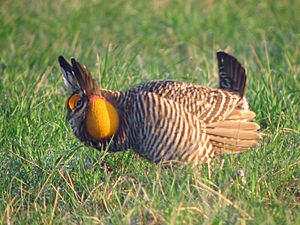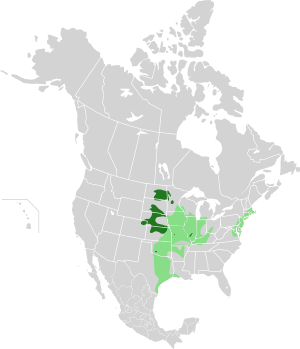Greater prairie-chicken facts for kids
Quick facts for kids Greater prairie-chicken |
|
|---|---|
 |
|
| Male displaying in Illinois, USA | |
| Conservation status | |
| Scientific classification | |
| Genus: |
Tympanuchus
|
| Species: |
cupido
|
| Subspecies | |
|
T. c. attwateri |
|
 |
|
| Distribution map of the greater prairie-chicken. Pale and dark green: pre-settlement Dark green: current year-round |
|
| Synonyms | |
|
Tetrao cupido Linnaeus, 1758 |
|
The greater prairie-chicken or pinnated grouse (Tympanuchus cupido), sometimes called a boomer, is a large bird in the grouse family. This North American species was once abundant, but has become extremely rare and extirpated over much of its range due to habitat loss. Conservation measures are underway to ensure the sustainability of existing small populations. One of the most famous aspects of these creatures is the mating ritual called booming.
Description
Adults of both sexes are medium to large chicken-like birds, stocky with round wings. They have short tails which are typically rounded. Adult males have orange comb-like feathers over their eyes and dark, elongated head feathers that can be raised or lain along neck. They also possess a circular, un-feathered neck patch which can be inflated while displaying; this, like their comb feathers, is also orange. As with many other bird species, the adult females have shorter head feathers and also lack the male's yellow comb and orange neck patch. Adults are about 43 cm (17 in) long, and weigh between 700–1,200 g (25–42 oz). The greater prairie-chicken has a wingspan range of 69.5–72.5 cm (27.4–28.5 in).
Subspecies
There are three subspecies;
- The heath hen, Tympanuchus cupido cupido, which was historically found along the Atlantic coast, is extinct. It was possibly a distinct species; in this case the two other forms would be T. pinnatus pinnatus and T. p. attwateri.
- Attwater's prairie-chicken, T. c. attwateri is endangered and restricted to coastal Texas.
- The greater prairie-chicken, T. c. pinnatus, is now restricted to a small section of its former range.
Population and habitat
The greater prairie-chicken prefers undisturbed prairie and was originally found in tallgrass prairies. It can tolerate agricultural land mixed with prairie, but sparser population density is found in areas that are more agricultural. Its diet consists primarily of seeds and fruit, but during the summer it also eats green plants and insects such as grasshoppers, crickets, and beetles. This species was once widespread all across the oak savanna and tall grass prairie ecosystem.
Conservation
The greater prairie-chicken was almost extinct in the 1930s due to hunting pressure and habitat loss. In Illinois alone, in the 1800s, the prairie-chicken numbered in the millions. It was a popular game bird, and like many prairie birds, which have also suffered massive habitat loss, it is now on the verge of extinction, with the wild bird population at around 200 in Illinois in 2019. It now only lives on small parcels of managed prairie land. Throughout North America, it is thought that their current population has declined severely, to approximately 500,000 individuals. In May 2000, the Canadian Species at Risk Act listed the greater prairie-chicken as extirpated in its Canadian range (Alberta, Saskatchewan, Manitoba, Ontario). It was again confirmed by the Committee on the Status of Endangered Wildlife in Canada in November 2009. Nonetheless, sightings and encounters continue to occur in the south-central regions of Alberta and Saskatchewan, along with southern Ontario, where sightings are extremely rare.
In states such as Iowa and Missouri that once had thriving prairie-chicken populations (estimated to be hundreds of thousands), total numbers have dropped to about 500. However, the Missouri Department of Conservation has started a program to import prairie-chickens from Kansas and Nebraska in the hopes that they will be able to repopulate the state and increase that number to 3,000.
Central Wisconsin is home to approximately 600 individuals, down from 55,000 when hunting was prohibited in 1954. Though this area was predominately spruce and tamarack marsh before European settlement, early pioneers drained the marshes and attempted to farm the poor soil. As the prairies to the south and west were lost to agriculture and development, and the southern half of Wisconsin was logged, the prairies spread northward into the abandoned farmland. Today, over 30,000 acres are managed by the Wisconsin Department of Natural Resources as greater prairie-chicken habitat. Birdwatchers travel from around the world to visit Wisconsin in April for the Central Wisconsin Prairie Chicken Festival, started in 2006 by Golden Sands Resource Conservation & Development Council, Inc.
Threats
Habitat loss is the greatest historical threat to prairie-chicken populations. More than 95% of all tallgrass prairie in the United States has been converted to cropland. The conversion of native prairie to cropland is very detrimental to these birds. It was found in a radio telemetry study conducted by Kansas State University that "most prairie-chicken hens avoided nesting or rearing their broods within a quarter-mile of power lines and within a third-mile of improved roads." (Kansas Department of Wildlife and Parks) It was also found that the prairie-chickens avoided communication towers and rural farms.
Studies have found mesopredators such as striped skunks, raccoons, and opossums significantly increase egg mortality; experimental removal of these predators increased nesting success from 33% to 82%. Loss of apex predators such as bears, wolves, and mountain lions results in increased populations of these mesopredators, and therefore reduces populations of prairie-chickens, an example of a top-down trophic cascade. Non-native common pheasants also reduce prairie-chicken reproduction through nest parasitism.
The small size of some isolated prairie-chicken populations in the Eastern portion of the range resulted in a population bottleneck, which reduced the genetic diversity and ultimately survival of offspring. In Illinois, wildlife management included the "genetic rescue" of small and potentially inbred populations by introducing birds from other areas.
See also
 In Spanish: Gallo de las praderas grande para niños
In Spanish: Gallo de las praderas grande para niños
- Lesser prairie chicken
- Lekking


